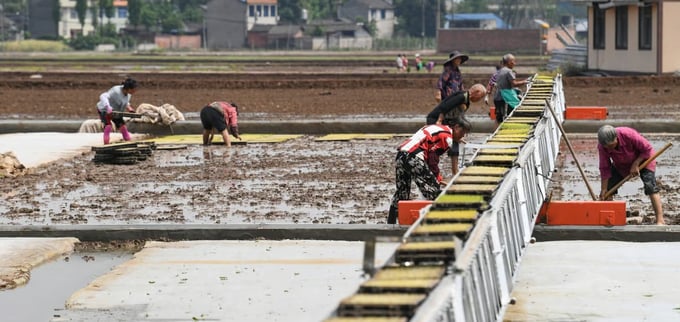June 10, 2025 | 22:05 GMT +7
June 10, 2025 | 22:05 GMT +7
Hotline: 0913.378.918
June 10, 2025 | 22:05 GMT +7
Hotline: 0913.378.918

President Xi Jinping has previously called for ‘Chinese people to hold the rice bowl in their own hands’, while in March, new Premier Li Qiang encouraged farmers to grow more crops to ensure Chinese ‘hold their bowls in their own hands’. Photo: Xinhua
China has significantly raised its grain self-sufficiency projections over the next decade by pledging to build a “diversified food supply system”, a move that has the potential to impact corn and soybean farmers in the United States and rice exporters in Thailand and Vietnam.
The flagship Agricultural Outlook Report for 2023-32 by the Ministry of Agriculture and Rural Affairs sets out China’s plan to grow 88.4 per cent of the grain – mainly referring to rice, wheat, corn and soybeans – it needs within a decade from the current level of 82 per cent.
It also plans to reduce grain imports to 122 million metric tonnes from last year’s 146.9 million metric tonnes, according to the report released by the agriculture ministry’s outlook committee on Monday.
“The foundation of grain security will be consolidated steadily,” it said, citing Beijing’s efforts to tap growth potential by increasing farming acreage and also promoting higher-yield seeds, farming machinery and technology.
“The agricultural trade structure will be changed significantly, with grain imports expected to fall 16 per cent over the next 10 years.”
Chinese leaders have repeated calls to ensure Chinese “hold their bowls in their own hands”.
President Xi Jinping also said at the end of last year that the global market turbulence caused by the Ukraine war had shown that agriculture is a “national security issue of extreme importance” amid the economic rivalry with the United States and other global geopolitical uncertainties.
Bulk purchase of agricultural products, mainly corn and soybeans, were often a tool used by Beijing to sweeten bilateral ties or leverage its demands during negotiations.
Beijing’s promise to buy a large amount of US soybeans and corn under the phase-one trade deal that was signed in early 2020 led to a significant rise of American agricultural exports over the past three years, although the two-year agreement expired in 2022.
China became the largest agricultural export market for the US last year, with exports reaching a record high of US$36.4 billion, including a record high soybean shipment value of US$16.4 billion, according to a report released by the US Department of Agriculture’s Foreign Agricultural Service in January.
“China does not have too much trouble with grain self-sufficiency now, but its soybean production is a more obvious shortcoming,” said Weng Ming, a researcher at the Institute of Rural Development under the Chinese Academy of Social Sciences.
Domestic soybean production in China is set to grow at an annual rate of 7 per cent over the next 10 years to lift the self-sufficiency ratio from 18.5 to 30 per cent.
China’s soybean imports could fall to 83.6 million metric tonnes by 2032, while corn imports would fall below 7 million metric tonnes from last year’s 20.6 million metric tonnes, the report estimated.
Its soybean imports dropped by 5.6 per cent year on year to 91.1 million metric tonnes last year, with Brazil providing 59.7 per cent and the US 32.4 per cent, according to China’s Ministry of Commerce.
China’s purchase of US corn dropped by a quarter to 14.9 million metric tonnes last year, or 72 per cent of its total.
“Although we have seen many recent technological breakthroughs in China’s agricultural sector, the biggest hurdle remains their practical application on farmland, and Beijing’s policies need to be practically implemented in the countryside,” Weng added.
China still needs to defend its farmland as local governments tend to sell more land for property and industrial development, which is forcing policymakers to increase grain yields through technology applications, Weng added.
Authorities have already pledged to ensure China has a total arable land of no less than 120 million hectares (297 million acres) in its 14th five-year plan for 2021-25 and to ensure food self-sufficiency as geopolitics have disrupted food supply chains and raised prices, while tensions with the West potentially threaten food imports.
The flagship agricultural outlook report for 2023-32 also outlined a plan to increase rice exports by 24 per cent in the next 10 years, which could affect the likes of Thailand and Vietnam.
Meanwhile, China also plans to increase the self-sufficiency ratio of oil crops – including soybeans, peanuts, rapeseed and sesame – from 32 per cent this year to 43.8 per cent by 2032.
China has already increased its guarantee of seed supply by 5 percentage points to 75 per cent in the last three years.
The world’s largest fruit consumer also plans to further increase research on indigenous tropical fruit varieties by bringing more tropical Southeast Asian varieties into domestic production, while maintaining its persistent trade deficit, the report added.
(SCMP)

(VAN) As of Friday, a salmonella outbreak linked to a California egg producer had sickened at least 79 people. Of the infected people, 21 hospitalizations were reported, U.S. health officials said.

(VAN) With the war ongoing, many Ukrainian farmers and rural farming families face limited access to their land due to mines and lack the financial resources to purchase needed agricultural inputs.

(VAN) Vikas Rambal has quietly built a $5 billion business empire in manufacturing, property and solar, and catapulted onto the Rich List.

(VAN) Available cropland now at less than five percent, according to latest geospatial assessment from FAO and UNOSAT.

(VAN) Alt Carbon has raised $12 million in a seed round as it plans to scale its carbon dioxide removal work in the South Asian nation.

(VAN) Attempts to bring down the price of the Japanese staple have had little effect amid a cost-of-living crisis.

(VAN) Fourth most important food crop in peril as Latin America and Caribbean suffer from slow-onset climate disaster.